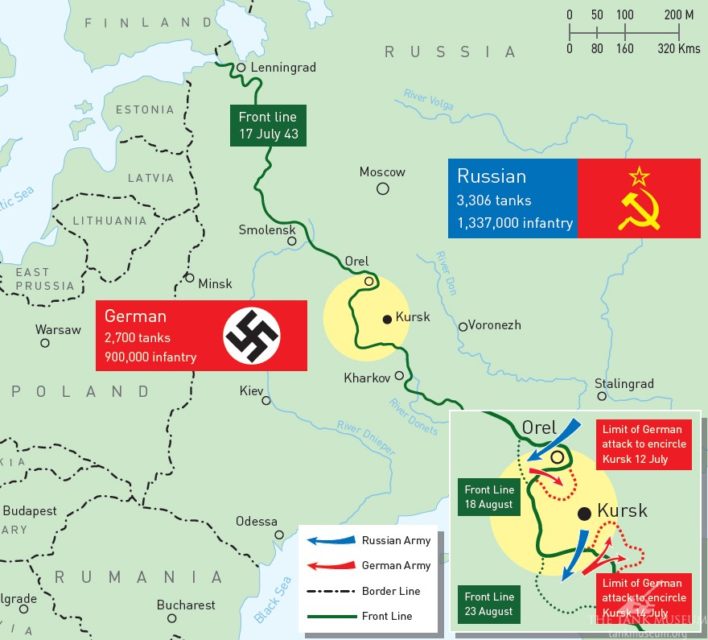The Battle of Kursk was one of the most decisive battles of the Second World War. Fought between the 5th July and 23rd August 1943, it began with a strong German attack, but ended with the Soviet Union having taken the initiative on the Eastern Front, something they kept for the rest of the war.
As the frozen Russian landscape began to thaw in the spring of 1943 the Eastern Front was brought to a temporary standstill. Roads turned to mud and rivers became impassable torrents as the snow and ice melted. After fighting in the winter of 1942-43 the front line around the city of Kursk had stabilised into a large Soviet salient.
This three-sided position was around 160 miles from north to south and extended up to 100 miles west into the German lines. It gave the Soviets a useful springboard to attack the Germans, but also offered the Germans an opportunity to close it with a pincer movement, trapping large Soviet forces. Both sides realised that the fighting to come this summer would be decisive in determining the outcome of the war in the east.
The German Plan
Their defeat at Stalingrad in February 1943 and losses since meant that the Germans were increasingly short of men and equipment. In March 1943 forces on the Eastern Front were 470,000 below their established strength, and had only around 600 operational tanks. They no longer had the strength to carry out a large scale offensive and settled on the Kursk salient as a more limited, manageable battlefield. If they could pinch it closed this would both destroy large Soviet forces and shorten the front line, improving their position.

Agreed in mid-March, Operation Citadel, as the Kursk attack was known, was originally scheduled for mid-April. This was far too soon for the depleted German forces, and it was repeatedly delayed in order to allow for the arrival of supplies, reinforcements and new weapons such as the Panther tank. The start date was eventually set for the 5th July.
The Germans massed around 777,000 men, 2451 tanks and assault guns and 7417 artillery pieces in 37 Infantry and Panzer Divisions, supported by over 1800 aircraft. The Northern attack was the responsibility of the Ninth Army, part of Army Group Centre, whereas in the South the Fourth Panzer Army and Army Detachment Kempf, both of Army Group South, would lead the offensive. The aim was for these forces to link up around Kursk itself.
The Soviet Plan
Unfortunately for the Germans, their plan for the Kursk salient was known to the Soviets, both because of the military logic, and because of intelligence gathered on the ground and from spies. As early as the end of March the location of the attack was known.

The Soviets considered a pre-emptive attack, but instead decided to defend. They would fortify the salient, defeat the German attacking forces then launch their own counterattack. The German delays gave the Soviets even more time to bring in reinforcements and to prepare successive defensive belts of minefields, anti-tank ditches, barbed wire, bunkers and other fortifications. They placed a heavy emphasis on anti-tank defence, creating strong points on likely avenues of attack and training the infantry to attack tanks at close range.
Unlike the Germans, the Red Army was getting stronger and its morale was improving. More and superior equipment was coming into service, and although soldiers were still very inexperienced the lessons of the first 2 years of war were being learned and acted upon.
The Soviets packed forces into the Salient. In the North the Central Front of 711,000 men, 1785 tanks and assault guns and 12,453 artillery pieces was positioned behind almost 80,000 mines. The Southern attack would be met by the Voronezh Front, consisting of 625,000 troops, 1704 tanks, 9751 guns and over 130,000 mines. Additional units in reserve meant that the Soviets had a total of more than 1,900,000 men, 5000 tanks, 31,000 guns and 3500 aircraft to meet the German attack.
A message from The Tank Museum:
“Please Support Us: As a charity, we rely on public support for all our activities. Our work is funded entirely by people like you. With your support, we can continue to create content. With the right support we might be able to do it more regularly – and can be even more ambitious. Please Click on the Banner Below.”
Thanks to the Tank Museum for this Blog, which originally appeared here.

